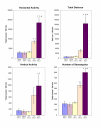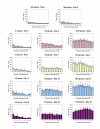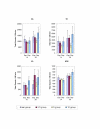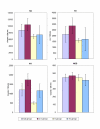Chronic exposure to MDMA (Ecstasy) elicits behavioral sensitization in rats but fails to induce cross-sensitization to other psychostimulants
- PMID: 16393341
- PMCID: PMC1360680
- DOI: 10.1186/1744-9081-2-1
Chronic exposure to MDMA (Ecstasy) elicits behavioral sensitization in rats but fails to induce cross-sensitization to other psychostimulants
Abstract
Background: The recreational use of 3,4-methylenedioxymethamphetamine (MDMA, ecstasy) among adolescents and young adults has become increasingly prevalent in recent years. While evidence suggests that the long-term consequences of MDMA use include neurodegeneration to serotonergic and, possibly, dopaminergic pathways, little is known about susceptibility, such as behavioral sensitization, to MDMA.
Methods: The objectives of this study were to examine the dose-response characteristics of acute and chronic MDMA administration in rats and to determine whether MDMA elicits behavioral sensitization and whether it cross-sensitizes with amphetamine and methylphenidate. Adult male Sprague-Dawley rats were randomly divided into three MDMA dosage groups (2.5 mg/kg, 5.0 mg/kg, and 10.0 mg/kg) and a saline control group (N = 9/group). All three MDMA groups were treated for six consecutive days, followed by a 5-day washout, and subsequently re-challenged with their respective doses of MDMA (day 13). Rats were then given an additional 25-day washout period, and re-challenged (day 38) with similar MDMA doses as before followed by either 0.6 mg/kg amphetamine or 2.5 mg/kg methylphenidate on the next day (day 39). Open-field locomotor activity was recorded using a computerized automated activity monitoring system.
Results: Acute injection of 2.5 mg/kg MDMA showed no significant difference in locomotor activity from rats given saline (control group), while animals receiving acute 5.0 mg/kg or 10.0 mg/kg MDMA showed significant increases in locomotor activity. Rats treated chronically with 5.0 mg/kg and 10.0 mg/kg MDMA doses exhibited an augmented response, i.e., behavioral sensitization, on experimental day 13 in at least one locomotor index. On experimental day 38, all three MDMA groups demonstrated sensitization to MDMA in at least one locomotor index. Amphetamine and methylphenidate administration to MDMA-sensitized animals did not elicit any significant change in locomotor activity compared to control animals.
Conclusion: MDMA sensitized to its own locomotor activating effects but did not elicit any cross-sensitization with amphetamine or methylphenidate.
Figures






Similar articles
-
Behavioral sensitization and cross-sensitization between methylphenidate amphetamine, and 3,4-methylenedioxymethamphetamine (MDMA) in female SD rats.Eur J Pharmacol. 2011 Jul 1;661(1-3):72-85. doi: 10.1016/j.ejphar.2011.04.035. Epub 2011 Apr 28. Eur J Pharmacol. 2011. PMID: 21549116 Free PMC article.
-
Chronic pretreatment with methylphenidate induces cross-sensitization with amphetamine.Life Sci. 2003 Oct 17;73(22):2899-911. doi: 10.1016/s0024-3205(03)00673-8. Life Sci. 2003. PMID: 14511774
-
Atypical development of behavioural sensitization to 3,4-methylenedioxymethamphetamine (MDMA, 'Ecstasy') in adolescent rats and its expression in adulthood: role of the MDMA chirality.Addict Biol. 2010 Jan;15(1):35-44. doi: 10.1111/j.1369-1600.2009.00187.x. Addict Biol. 2010. PMID: 20002021
-
Locomotor sensitization in male Sprague-Dawley rats following repeated concurrent treatment with 4-methylmethcathinone and 3,4-methylenedioxymethamphetamine.Behav Pharmacol. 2019 Oct;30(7):566-573. doi: 10.1097/FBP.0000000000000491. Behav Pharmacol. 2019. PMID: 31268871
-
The role of age, genotype, sex, and route of acute and chronic administration of methylphenidate: a review of its locomotor effects.Brain Res Bull. 2006 Feb 15;68(6):393-405. doi: 10.1016/j.brainresbull.2005.10.005. Epub 2005 Oct 27. Brain Res Bull. 2006. PMID: 16459193 Review.
Cited by
-
Ethanol-MDMA interactions in rats: the importance of interval between repeated treatments in biobehavioral tolerance and sensitization to the combination.Psychopharmacology (Berl). 2007 Jul;192(4):555-69. doi: 10.1007/s00213-007-0752-9. Epub 2007 Mar 8. Psychopharmacology (Berl). 2007. PMID: 17345065
-
Repeated exposure to MDMA and amphetamine: sensitization, cross-sensitization, and response to dopamine D₁- and D₂-like agonists.Psychopharmacology (Berl). 2012 Oct;223(4):389-99. doi: 10.1007/s00213-012-2726-9. Epub 2012 May 5. Psychopharmacology (Berl). 2012. PMID: 22562523
-
Effect of MDMA (ecstasy) on activity and cocaine conditioned place preference in adult and adolescent rats.Neurotoxicol Teratol. 2007 Jan-Feb;29(1):37-46. doi: 10.1016/j.ntt.2006.09.002. Epub 2006 Sep 14. Neurotoxicol Teratol. 2007. PMID: 17049207 Free PMC article.
-
Mephedrone interactions with cocaine: prior exposure to the 'bath salt' constituent enhances cocaine-induced locomotor activation in rats.Behav Pharmacol. 2013 Dec;24(8):684-8. doi: 10.1097/FBP.0000000000000006. Behav Pharmacol. 2013. PMID: 24126218 Free PMC article.
-
MDMA (N-methyl-3,4-methylenedioxyamphetamine) and its stereoisomers: Similarities and differences in behavioral effects in an automated activity apparatus in mice.Pharmacol Biochem Behav. 2008 Jan;88(3):318-31. doi: 10.1016/j.pbb.2007.09.002. Epub 2007 Sep 14. Pharmacol Biochem Behav. 2008. PMID: 17904622 Free PMC article.
References
-
- Johnston LD, O'Malley PM, Bachman JG. Monitoring the Future national results on adolescent drug use: Overview of key findings, 2002. National Institutes on Drug Abuse. 2003;NIH Publication No. 03-5374
-
- Landry MJ. MDMA: a review of epidemiologic data. J Psychoactive Drugs. 2002;34:163–169. - PubMed
-
- Williams MT, Morford LL, Wood SL, Rock SL, McCrea AE, Fukumura M, Wallace TL, Broening HW, Moran MS, Vorhees CV. Developmental 3,4-methylenedioxymethamphetamine (MDMA) impairs sequential and spatial but not cued learning independent of growth, litter effects or injection stress. Brain Res. 2003;968:89–101. doi: 10.1016/S0006-8993(02)04278-6. - DOI - PubMed
Grants and funding
LinkOut - more resources
Full Text Sources

